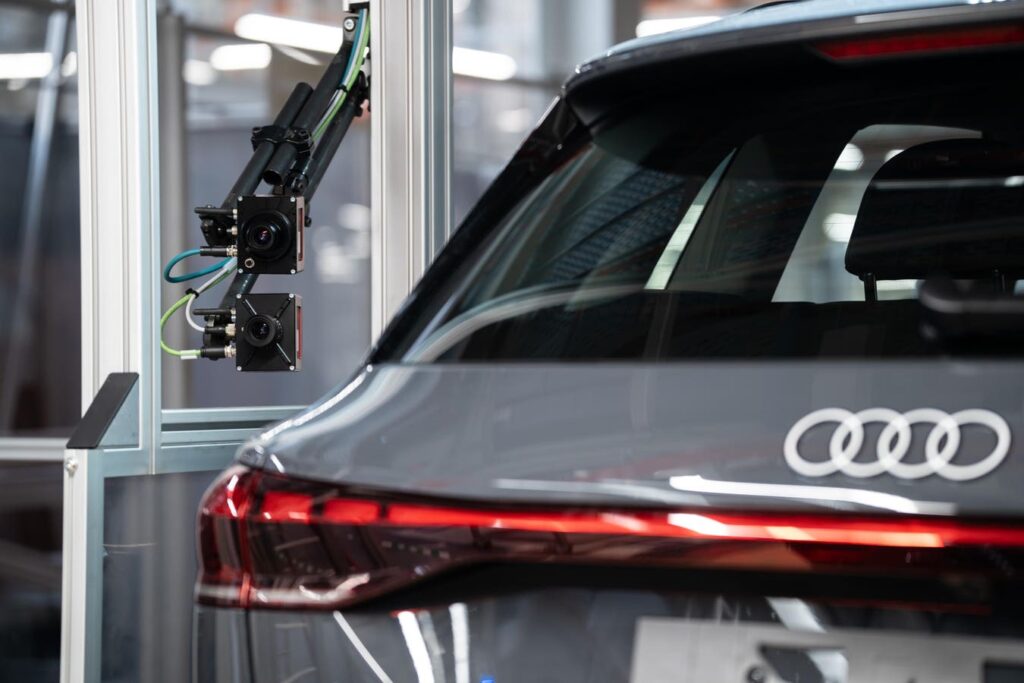“IRIS” uses cameras to check if labels showing technical information are applied to the vehicle … More
While many automotive AI headlines focus on self-driving cars or flashy infotainment upgrades, Audi is quietly building something more foundational: AI that runs the factory floor.
In a June 2 briefing, the German automaker revealed that more than 100 AI projects are now in operation or development across its global production network. These systems are doing real work from inspecting welds and predicting equipment failures to optimizing logistics and assisting human workers in tasks that range from parts flow to process simulation.
“Artificial intelligence is the game changer in our industry,” said Gerd Walker, Audi’s Board Member for Production and Logistics. “By using it in a targeted way, we are creating a production environment that is not only more efficient and cost-effective but that also meets the highest quality standards.”
Audi shares that these AI projects aren’t just limited pilots or technology-focused proofs-of-concept. Instead, Audi has implemented AI across its factories to guide decision-making and production at scale.
AI as a Core Part of Manufacturing Infrastructure
What makes Audi’s approach to AI stand out is how deeply it’s embedded. Most manufacturers have tested AI in narrow contexts, such as visual inspections, coordination of robotic assembly, supply chain forecasting, or predictive analytics. Audi is pushing past those point use cases, creating a more full-stack approach to AI in the production environment that can adapt dynamically.
Its computer vision systems now inspect surface finishes and structural welds with high degrees of consistency and accuracy. Its “Weld Splatter Detection” (WSD) application uses AI to detect possible weld splatter on vehicle underbodies and its IRIS tool uses computer vision-powered cameras to verify whether labels with the correct technical data in the right language are correctly attached to the vehicle
Generative AI models simulate factory layouts and help plan production changes before implementation. Predictive maintenance tools, trained on petabytes of machine and sensor data, flag potential issues days or weeks before they become problems.
The company’s “Tender Toucan” tool analyzes bids as part of its procurement process, using specifications to create a list of requirements, then using that information to search for the relevant sections in the bids, and evaluates the degree to which they are fulfilled. Employees have reported time savings of up to 30 percent.
From Data Swamps to Adaptive Systems
Even though AI technology gets the attention, the real breakthrough at Audi is data utilization. Audi’s plants generate staggering volumes of data daily, with multiple petabytes across sensors, robotics, and logistics systems. Rather than treat this as digital exhaust that ends up unused in the organization’s data “swamp”, Audi uses it to train machine learning models that constantly refine how production is run.
In some facilities, these models have helped cut unplanned machine downtime by nearly 30%. In others, they’re shortening assembly time by fine-tuning when and how components arrive at specific stations.
“Artificial intelligence enables us to make more extensive use of our enormous wealth of data in production and accelerates the journey of our 360factory towards becoming a data-driven factory,” said Walker.
Audi shares that the 360factory is the company’s production strategy for fully connected, innovative, and sustainable manufacturing.
Smart Factories That Learn on the Job
Audi’s push reflects a bigger transition in how manufacturers view production. Rather than see factories as fixed systems with rigid processes, companies like Audi are turning them into adaptive environments, more like living systems than static machines.
AI is helping these manufacturers handle disruptions in supply chains, reconfigure workflows faster, and plan for increasingly customized vehicle production runs, especially in a more challenging global political and economic environment.
Other carmakers are moving in this direction. Porsche has deployed AI to monitor welding quality in Leipzig. BMW has extended AI to final inspection steps. Tesla has integrated AI into robot programming and vision systems. Few have gone as far as Audi in weaving AI into the full production lifecycle, but clearly that is the direction the industry is heading.
The Shift: From Feature to Fabric
Most corporate AI deployments today fall into a predictable pattern: one tool for one job. Audi’s strategy shows what happens when AI becomes part of the operating fabric.
That distinction matters. It suggests a future in which AI doesn’t just “assist”, but rather it becomes the connective tissue linking systems, people, and decisions. Think less about dashboards and more about real-time optimization happening invisibly behind the scenes.
This approach also reflects a shift in AI maturity. The conversation is moving from capability to utility. Companies like Audi are proving that what matters most now isn’t what AI can do, but what it can do to change the way an organization operates.
Read the full article here
